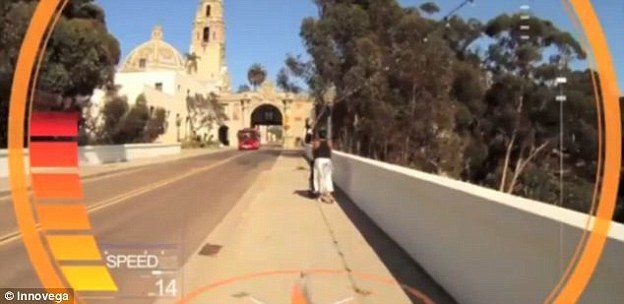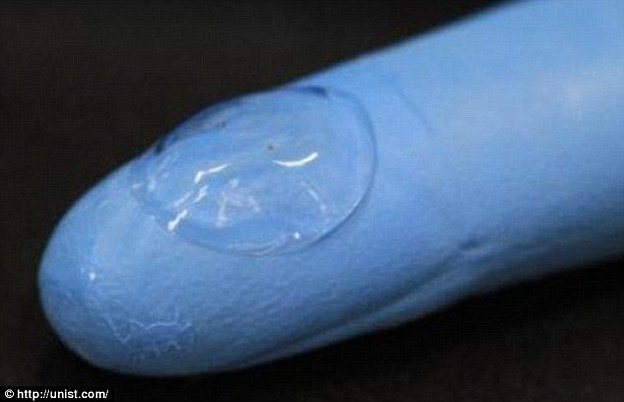Now that's an EYE-Max! 3D printed CONTACT LENSES could beam videos straight into your eyes!Scientists from Princeton University in New Jersey have managed to make a 3D printer that can create a five layered contact lens.The lens is a transparent polymer with tiny ‘quantum dot’ light-emitting diodes and wires hidden inside that form electrical circuits.One layer of the lens beams light into a wearer's eye - and could in the future be used as a heads up display to show data or even videos.The US Air Force is funding the research and hopes that it could one day be used to show pilots information and monitor their health and alertness.
You may have to switch on the TV or go to the cinema to watch a film, but in the future you could wear hi-tech contact lenses to beam moving images onto your eyeballs.
3D printed contact lenses could also be used like Google Glass or a heads up display to show wearers data and even monitor their health, researchers claim.
US scientists have taken the first step to make this possible, because they have managed to make a 3D printer that can create a five layered contact lens, where one layer beams light into the wearer’s eye.
Scroll down for video

US scientists have managed to make a 3D printer that can create a five layered contact lens, where one layer beams light into the wearer’s eye. A stock image of a standard contact lens is pictured
US scientists have managed to make a 3D printer that can create a five layered contact lens, where one layer beams light into the wearer’s eye. A stock image of a standard contact lens is pictured
Michael McAlpine led a team at Princeton University to build the complex machine, which in turn made the new type of lens New Scientist reported.
3D printers typically build up metallic or polymer material to form objects, as instructed by computer code, which tells the machines the desired dimensions and appearance of the end product. But this machine is more complex.
The lens printed by the machine is a transparent polymer with tiny ‘quantum dot’ light-emitting diodes and wires hidden inside that form electrical circuits.
Dr McAlpine said that the most challenging part of the project was working out the best chemical solvents to use in order to create each layer and how long to leave them to dry for the next layer to stick correctly.

3D printers (stock image) typically build up metallic or polymer material to form objects, as instructed by computer code, which tells the machines the desired dimensions of the end product. But this machine is more complex and can embed the tiniest electrical components in layers of polymer
The team also had to work out a way of enabling the lenses to fit differently shaped eyeballs.
To do this, they constantly scanned the lens with two cameras to check the final shape matched the wearer’s prescription.
The US Air Force funded the research, because it one day hopes its pilots will be able to wear contact lenses that display in-flight data, like a heads up display for the eyeballs.
If the LEDS were replaced by light sensors, such lenses could also be used to monitor a pilots’ health without the need for an invasive implant, by studying changes of the retina.
Dr McAlpine said that a sensor could be embedded inside them to detect fatigue in the eye fluids, and therefore if a pilot is exhausted.
COULD CONTACT LENSES REPLACE TV SCREENS?
The race is on to roll out contact lenses that consumers can wear to watch video.
Unveiled earlier this year, a system by iOptik allows users to see projected digital information (like Google Glass) so that tiny screens sit directly on their eyeballs.
However, a pair of lightweight glasses made by Washington-based Innovega, have to be worn for the lenses to work.
They provide an experience equivalent to watching a 240-inch television at a distance of 10 feet, according to the company's chief executive, Steve Willey.
The system works with smartphones and portable game devices to deliver video - or can be switched to a translucent 'augmented reality' view, where computer information is layered over the world we know it.

Unveiled earlier this year, a system by iOptik allows users to see projected digital information (like Google Glass) so that tiny screens sit directly on their eyeballs. A concept image is shown
Innovega customised the standard contact lens manufacturing process with a unique filter to make the contact lenses.
'All the usual optics in the eyewear are taken away and there is a sub-millimetre lens right in the centre,' MD Stephen Willey told CNET.
'It's shaped, so the outside of the lens is shaped to your prescription if you need one and the very centre of the lens is a bump that allows you to see incredibly well half an inch from your eye.'
An optical filter also directs the light. 'Light coming from outside the world is shunted to your normal prescription. Light from that very near display goes through the centre of the lens, the optical filter,' Mr Willey said
Last year, South Korean scientists created soft contact lenses fitted with LEDs, bringing the possibility of transparent, flexible materials that can be programmed to take pictures a step closer to reality.

Last year, South Korean scientists created soft contact lenses fitted with LEDs (pictured), bringing the possibility of transparent, flexible materials that can be programmed to take pictures a step closer to reality
Unlike the iOptik, which requires glasses to work, these contact lenses can be used as standalone systems capable of performing tasks such as taking pictures.
Microsoft and the University of Washington have also been working on similar projects that seem more like a prop in movies such as Mission Impossible 4.
In 2012, they created a prototype of a hard augmented reality contact lens capable of receiving radio signals and transmitting them to the brain through optical nerves.
3D-Print Today is an online news magazine bringing you up to date on all the latest news from the 3D Printing Industry. We work hard on finding interesting and unique news stories and fresh trends on the market.
Our online magazine provides a compelling blend of daily articles, fresh news, blog posts and opinions, as well as videos and visuals across all platforms through our main website, our mobile application and the social media network; all contains the detailed information and up to date news, for you to discover the amazing world of 3D Printing.
245 Greene Street
New York, NY 10012